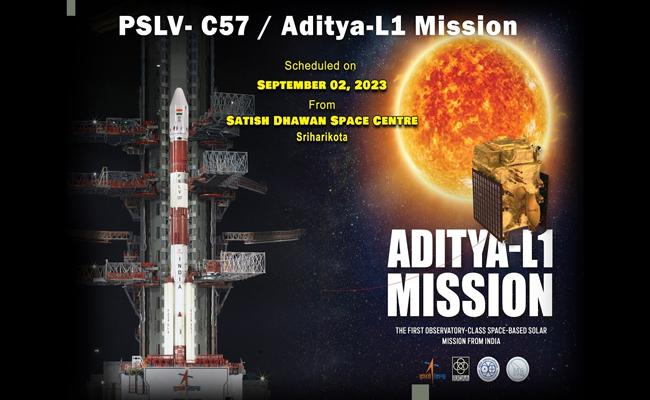ISRO's Aditya L1 Mission Successfully Launched

ISRO scientists has launched Aditya L1 at 11.50 am on Saturday.
All tests of PSLV C57 rocket have been conducted and handed over to the Launch Authorization Board (Lab). Lab Chairman Rajarajan once again conducted tests for the rocket and officially announced the countdown and launch time. Many people have a suspicion that the sun is a burning ball of fire. If a satellite is sent there, it will burn.
ISRO's Successful Missions Until Date:
- Aryabhata - 1975
- INSAT Series - 1983
- GSAT Series
- Chandrayaan-1 2008
- MARS Orbiter Mission - 2014
- Chandrayaan-3 2023
15 lakh kilometers from the Earth
The Aditya-L1 satellite weighing about 1,470 kg will be launched into an orbit around the Langregian Point-1 (L-1), which is 15 lakh kilometers from the Earth towards the Sun. This allows for continuous study of the solar system regardless of eclipses. ISRO scientists say that it will take 175 days to reach there.
ISRO's Aditya-L1, the first space-based Indian observatory to study the Sun will be launched on Saturday at 11.50 hrs from Srihari Kota space station in Andhra Pradesh. The satellite will be placed in a halo orbit around the Lagrange point L1 of the Sun-Earth system which is about 1.5 million kms from the Earth.
ISRO tweeted that "Citizens are invited to witness the launch from the Launch View Gallery at Sriharikota by registering here: https://lvg.shar.gov.in/VSCREGISTRATION/index.jsp Commencement of registration will be announced there."
🚀PSLV-C57/🛰️Aditya-L1 Mission:
— ISRO (@isro) August 28, 2023
The launch of Aditya-L1,
the first space-based Indian observatory to study the Sun ☀️, is scheduled for
🗓️September 2, 2023, at
🕛11:50 Hrs. IST from Sriharikota.
Citizens are invited to witness the launch from the Launch View Gallery at… pic.twitter.com/bjhM5mZNrx
It will take around four months to reach the Lagrange point. The advantage of a halo orbit around the L1 point is that the satellite can observe the solar activities without any obstruction by other celestial activities like eclipse.
The Aditya L1 mission
Its mission is to study the solar winds and the Sun’s atmosphere. It will carry seven payloads to observe the photosphere, chromosphere, and the outermost layers of the Sun namely the corona. This will help understand the problems of coronal heating, Coronal mass ejection, pre-flare and flare activities, dynamics of weather, and the study of the propagation of particles and fields in the interplanetary medium.
All about ADITYA -L1; the first space based Indian mission to study the Sun!
Aditya L1 shall be the first space based Indian mission to study the Sun. The spacecraft shall be placed in a halo orbit around the Lagrange point 1 (L1) of the Sun-Earth system, which is about 1.5 million km from the Earth.
A satellite placed in the halo orbit around the L1 point has the major advantage of continuously viewing the Sun without any occultation/eclipses. This will provide a greater advantage of observing the solar activities and its effect on space weather in real time. The spacecraft carries seven payloads to observe the photosphere, chromosphere and the outermost layers of the Sun (the corona) using electromagnetic and particle and magnetic field detectors. Using the special vantage point L1, four payloads directly view the Sun and the remaining three payloads carry out in-situ studies of particles and fields at the Lagrange point L1, thus providing important scientific studies of the propagatory effect of solar dynamics in the interplanetary medium.
The suits of Aditya L1 payloads are expected to provide most crucial information to understand the problem of coronal heating, coronal mass ejection, pre-flare and flare activities and their characteristics, dynamics of space weather, propagation of particle and fields etc.
The major science objectives of Aditya-L1 mission are:
- Study of Solar upper atmospheric (chromosphere and corona) dynamics.
- Study of chromospheric and coronal heating, physics of the partially ionized plasma, initiation of the coronal mass ejections, and flares
- Observe the in-situ particle and plasma environment providing data for the study of particle dynamics from the Sun.
- Physics of solar corona and its heating mechanism.
- Diagnostics of the coronal and coronal loops plasma: Temperature, velocity and density.
- Development, dynamics and origin of CMEs.
- Identify the sequence of processes that occur at multiple layers (chromosphere, base and extended corona) which eventually leads to solar eruptive events.
- Magnetic field topology and magnetic field measurements in the solar corona.
- Drivers for space weather (origin, composition and dynamics of solar wind.
- The instruments of Aditya-L1 are tuned to observe the solar atmosphere mainly the chromosphere and corona. In-situ instruments will observe the local environment at L1. There are total seven payloads on-board with four of them carrying out remote sensing of the Sun and three of them carrying in-situ observation.
Payloads along with their major capability of scientific investigation
|
Type |
Sl. No. |
Payload |
Capability |
|
Remote Sensing Payloads |
1 |
Visible Emission Line Coronagraph(VELC) |
Corona/Imaging & Spectroscopy |
|
2 |
Solar Ultraviolet Imaging Telescope (SUIT) |
Photosphere and Chromosphere Imaging- Narrow & Broadband |
|
|
3 |
Solar Low Energy X-ray Spectrometer (SoLEXS) |
Soft X-ray spectrometer: Sun-as-a-star observation |
|
|
4 |
High Energy L1 Orbiting X-ray Spectrometer(HEL1OS) |
Hard X-ray spectrometer: Sun-as-a-star observation |
|
|
In-situ Payloads |
|||
|
5 |
Aditya Solar wind Particle Experiment(ASPEX) |
Solar wind/Particle Analyzer Protons & Heavier Ions with directions |
|
|
6 |
Plasma Analyser Package For Aditya (PAPA) |
Solar wind/Particle Analyzer Electrons & Heavier Ions with directions |
|
|
7 |
Advanced Tri-axial High Resolution Digital Magnetometers |
In-situ magnetic field (Bx, By and Bz). |




















